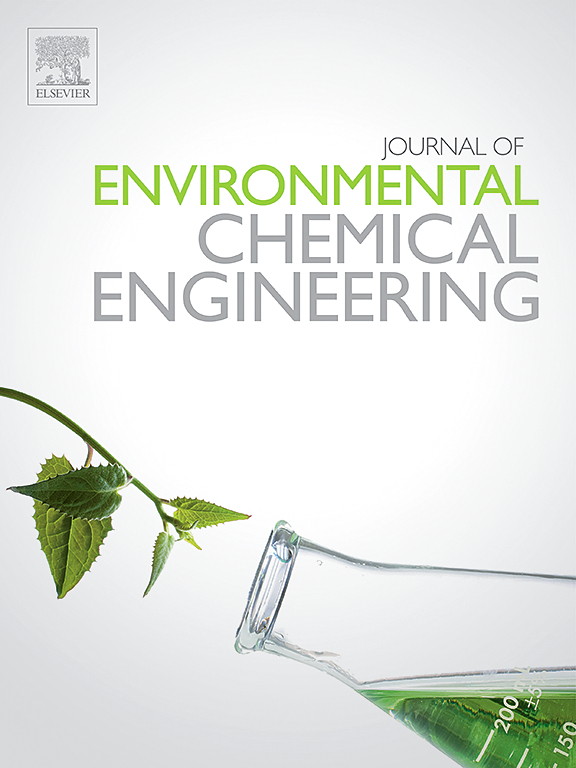Deep CO2 photoreduction by synergy of K+ doping and defective modulation over TiO2@K2Ti6O13 nanoribbon heterojunctions
IF 7.4
2区 工程技术
Q1 ENGINEERING, CHEMICAL
引用次数: 0
Abstract
The contemporary issues of energy shortages and global warming, attributable to the substantial utilization of fossil fuels, require immediate consideration and remedial action. Photocatalytic CO2 reduction (CO2RR) technology is a promising approach to mitigate climate change and address current energy shortages. However, slow charge dynamics and low affinity for intermediates on photocatalysts remain significant challenges in photocatalytic CO2 reduction. In this study, we have synthesized a series of TiO2@K2Ti6O13 (KTO) heterojunctions for gas-solid phase photocatalytic CO2 reduction by incorporating K-doped defective TiO2 during the construction of KTO nanoribbons using a simple hydrothermal method. The presence of oxygen vacancies and the formation of type II heterojunctions provided a driving force for the transfer of photoexcited carriers, which modulated the electronic properties of the catalyst surface through the built-in electric field. Density functional theory (DFT) calculations and experimental results show that in Ov-K/TiO2, K+ doping and oxygen vacancies (Ov) synergistically modulate the charge density of Ti active sites, thereby promoting the adsorption and activation of CO* intermediates. This enhancement resulted in Ov-K/TiO2@KTO-2 exhibiting improved CO2 conversion capacity and enhanced CH4 selectivity. This work provides a simple method to synthesize efficient TiO2-based photocatalysts for selective CH4 production and also offers a general platform for designing high-performance synergistic catalysts for efficient solar energy conversion.
K+掺杂和TiO2@K2Ti6O13纳米带异质结缺陷调制协同作用下的CO2深度光还原
由于大量使用矿物燃料而造成的能源短缺和全球变暖等当代问题需要立即加以审议和采取补救行动。光催化二氧化碳还原(CO2RR)技术是缓解气候变化和解决当前能源短缺的一种有前途的方法。然而,缓慢的电荷动力学和光催化中间体的低亲和力仍然是光催化CO2还原的重大挑战。在本研究中,我们利用简单的水热法在构建KTO纳米带的过程中加入k掺杂缺陷TiO2,合成了一系列用于气固相光催化CO2还原的TiO2@K2Ti6O13 (KTO)异质结。氧空位的存在和II型异质结的形成为光激发载流子的转移提供了动力,这种载流子通过内置电场调节催化剂表面的电子性质。密度泛函理论(DFT)计算和实验结果表明,在Ov-K/TiO2中,K+掺杂和氧空位(Ov)协同调节Ti活性位点的电荷密度,从而促进CO*中间体的吸附和活化。这种增强导致Ov-K/TiO2@KTO-2表现出改善的CO2转化能力和增强的CH4选择性。本研究提供了一种简单的方法来合成高效的二氧化钛基光催化剂,用于选择性生产CH4,也为设计高效太阳能转化的高性能协同催化剂提供了一个通用平台。
本文章由计算机程序翻译,如有差异,请以英文原文为准。
求助全文
约1分钟内获得全文
求助全文
来源期刊

Journal of Environmental Chemical Engineering
Environmental Science-Pollution
CiteScore
11.40
自引率
6.50%
发文量
2017
审稿时长
27 days
期刊介绍:
The Journal of Environmental Chemical Engineering (JECE) serves as a platform for the dissemination of original and innovative research focusing on the advancement of environmentally-friendly, sustainable technologies. JECE emphasizes the transition towards a carbon-neutral circular economy and a self-sufficient bio-based economy. Topics covered include soil, water, wastewater, and air decontamination; pollution monitoring, prevention, and control; advanced analytics, sensors, impact and risk assessment methodologies in environmental chemical engineering; resource recovery (water, nutrients, materials, energy); industrial ecology; valorization of waste streams; waste management (including e-waste); climate-water-energy-food nexus; novel materials for environmental, chemical, and energy applications; sustainability and environmental safety; water digitalization, water data science, and machine learning; process integration and intensification; recent developments in green chemistry for synthesis, catalysis, and energy; and original research on contaminants of emerging concern, persistent chemicals, and priority substances, including microplastics, nanoplastics, nanomaterials, micropollutants, antimicrobial resistance genes, and emerging pathogens (viruses, bacteria, parasites) of environmental significance.
 求助内容:
求助内容: 应助结果提醒方式:
应助结果提醒方式:


